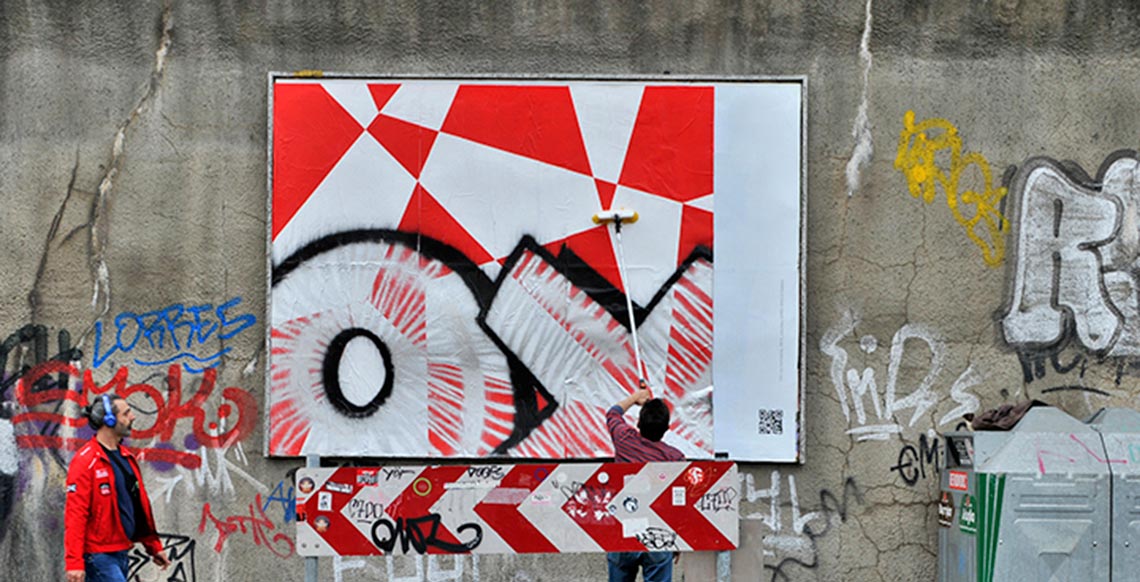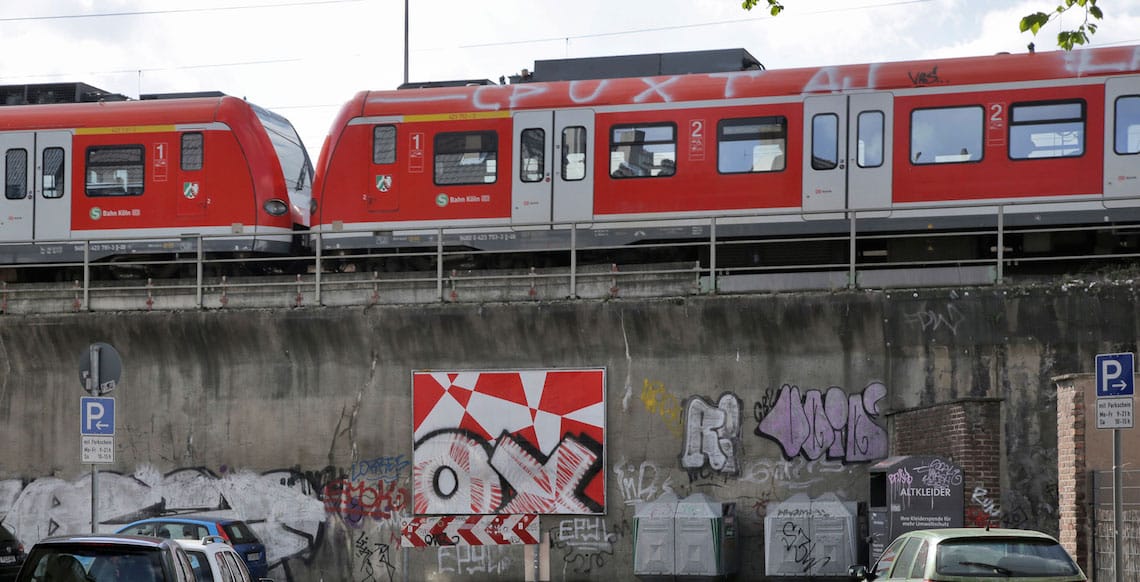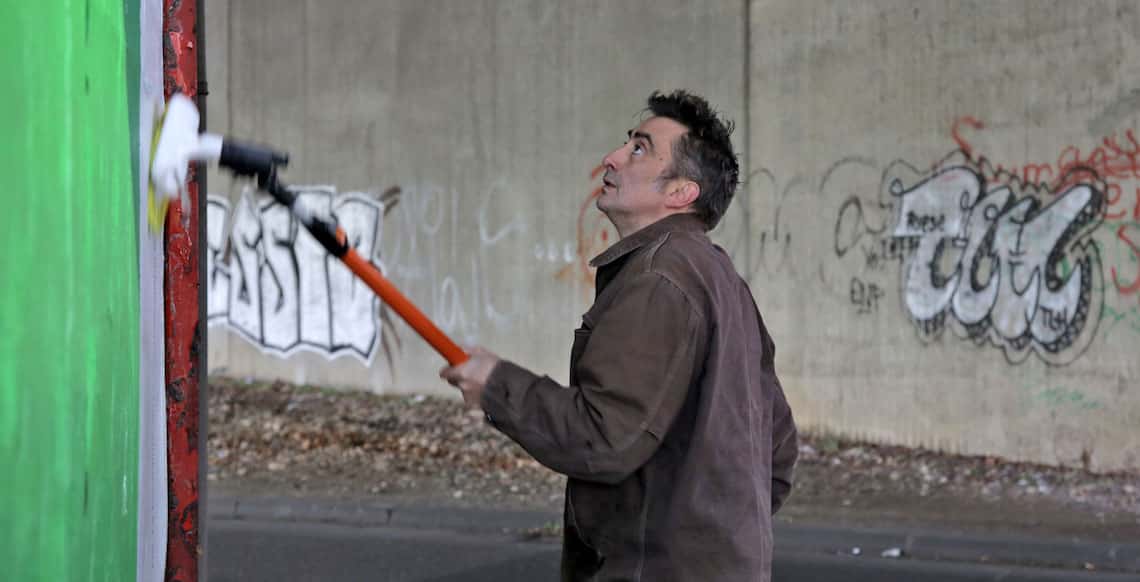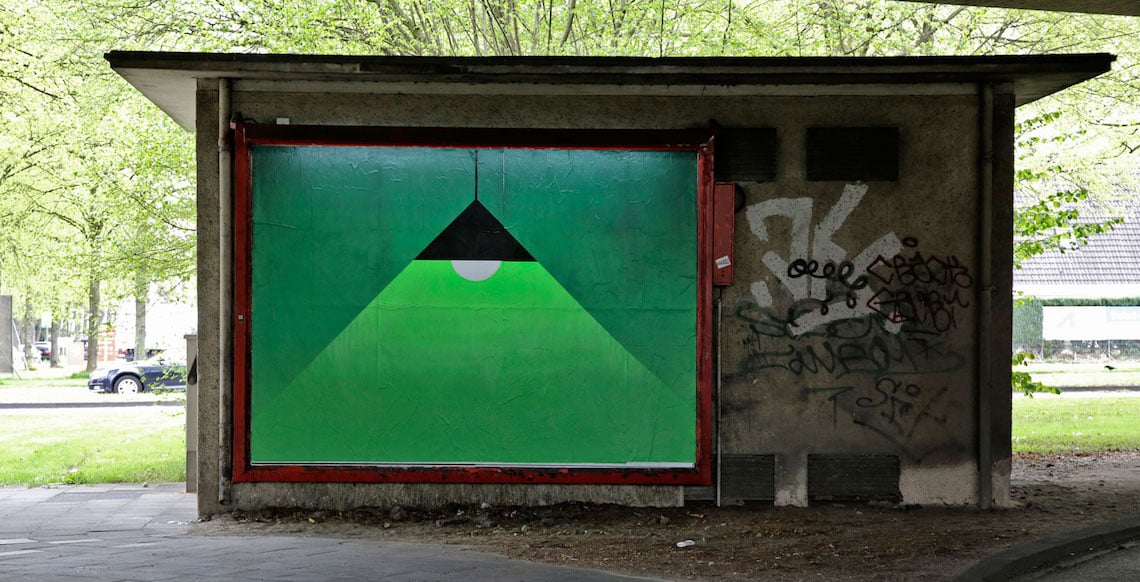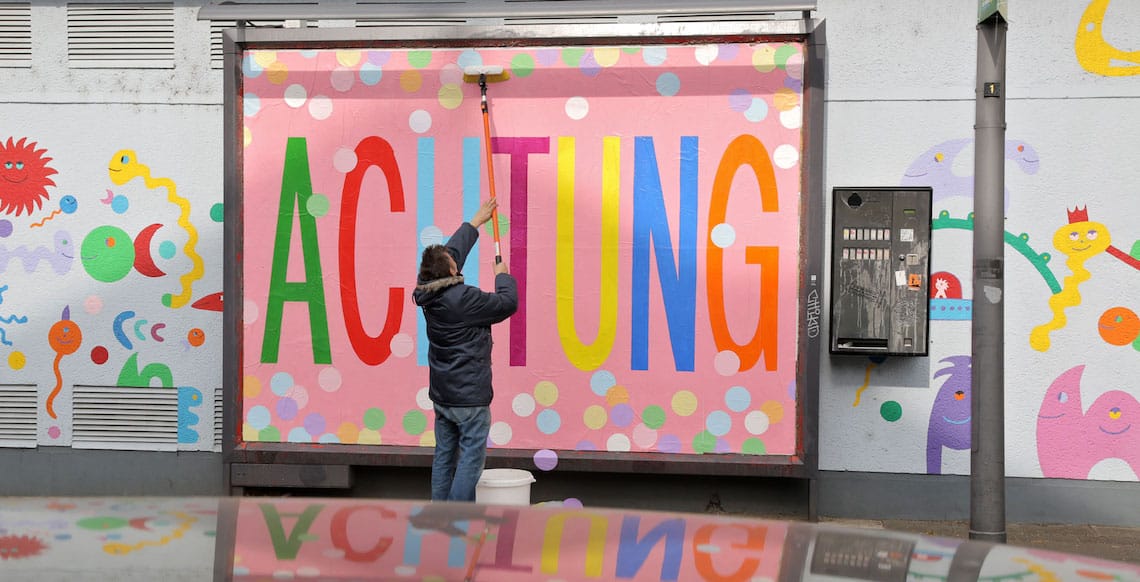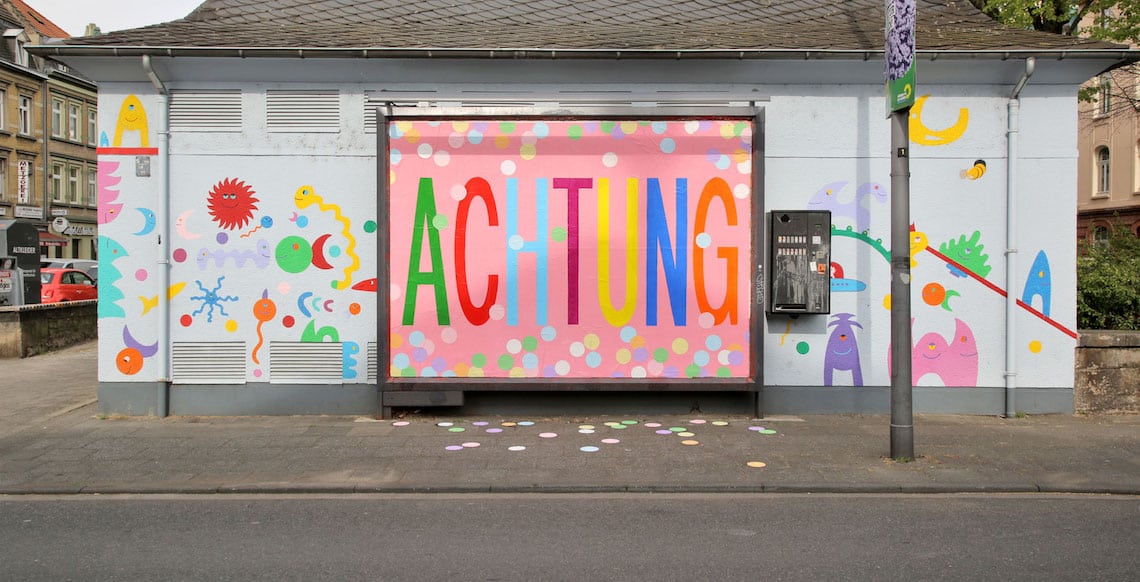Biography
All of the urban dwellers around the globe have one particular thing in common, something they might not even be aware of, but something that they encounter every day: all of them cannot go about their daily lives without seeing a billboard advertisement. Located in high-traffic areas, alongside busy roads, these large, colorful messages have a goal to attract people’s attention and to sell them the advertised product. Bombarded with hordes of aggressive images, city dwellers have virtually no time to make a real decision and their minds are easily influenced according to the marketing aims. Using attractive visuals normally found in magazines, billboards are the favorite broadcasting medium of corporations, but also of many political campaigns, shaping the public opinion and keeping it pliant. Designed to persuade, these messages make an impact on the social order, but their content is always superficial and their purpose is often flawed. The main goal for the French artist OX is to change this very purpose.
The hijacker of billboards, OX, is recognized for his practice of taking over these huge advertisements, adorning them in a cloak of humor with irresistible simplicity. “Advertising billboards are like huge windows, oversized paintings, hanging in the city,” OX says, explaining why he is attracted to these particular visual spaces. His artistic concept is based on the philosophy of culture jamming, a practice that suggests physical alterations to large outdoor advertising structures. This French renegade nurtures an aesthetic of shock within his highly recognizable visual language, characterized by minimalist imagery cleverly embedded inside a commercial message. With a long-standing career behind him, OX is one of the most revered culture jammers today.
OX’s Beginnings
OX was born in 1963 in the north-east of France, in the city of Troyes. He chose to work in the public space in the 1980s, long before the term street-art existed and graffiti became a cult. For a while, he followed courses to become an advertisement designer in Paris but soon moved to the famous École des Arts Décoratifs. His objective was to master the art of painting, silkscreen, and video. During his studies, the artist was impressed by several exhibitions he visited including those of Roy Lichtenstein and Frank Stella, while he discovered the work Keith Haring at the same time. In 1983, he took part in the making of the Blank graphzine, alongside artists such as Pascal Doury and Nina Kuss from the band Lucrate Milk. Their early screen print and photocopy-based graphic works were soon replaced by live painting sessions during punk-rock concerts. This was the first occasion the artist exhibited a strong inclination for action art. At the same time, he adopted a new pseudonym made of two simple, reversible letters O and X, a title that became his signature in the following years.
Collaboration with Jean Faucheur
In 1984, OX met Jean Faucheur, one of the pioneers of Street Art in France and a forerunner of the adbusting movement. This meeting marked a turning point in OX’s career and he became a member of the legendary group “Les Frères Ripoulin“, along with Pierre Huyghe, Claude Closky and several other prominent artists. His fellow artists of the Blank graphzine also joined the artistic collective. As a group, they started to occupy billboards and treat them as exhibition spaces for their own art. Often associated with a French art movement Figuration Libre, the group kept contact with Warhol’s Factory and Jean-Michel Basquiat. One of the artists they maintained close relations with is Keith Haring, who painted a poster in their studio and pasted it on one of the 22 advertising boards of the Dupleix metro station taken over for the occasion. The event was well covered by the media, and Agnès b, who had just opened the Galerie du Jour, hosted the debut show by “Les Frères Ripoulin”.
When the collective was invited to exhibit at NY Shafrazy Gallery in 1984, OX decided to leave school for good and to devote himself to art.
OX’s Visual Language
During his time with the group, OX participated in several collective shows and projects with “Les Frères Ripoulin”, before they split in 1988. For a while, he focused primarily on studio painting but in 1993, he was back on the streets. “I was not very happy with my exhibitions in the galleries,” he said.
This was the first time in OX’s career that he was placing paste-ups on his own in public and the gigantic billboards soon became his medium of choice. He liked the style of Victor Vasarely and geometric abstraction, and inspired by it he started to simplify the shapes by removing everything he found unimportant. This reductive process was crucial in the development of his studious, minimalist visual language. OX’s famous “Affichages”, as he likes to call his works, are composed of simple, minimal forms, geometric and abstract structures that conceptually extend outside of the frame. Such a straightforward abstract geometry recalls the flattened colors of Mark Rothko and suggests an existence of imaginary worlds in a rather surrealistic manner. “It’s a question of aesthetics, of producing emotions. The explanations are not necessary,” claims OX, as he mixes the style of avant-garde movements with the commercial visual plane. His public interventions make billboards visually striking, entirely harmonized with the urban landscape. Armed with his paper prints, cutouts, rollers, and glue, the artist turns advertisements into islands of coloristic splendor that interact with their surroundings. While billboard ads are designed to attract attention and make a strong impression very quickly, OX creates works that open up doors to a meditative realm, initially alluring the viewer with humor. Disrupting the monotonous cityscape, he makes room for individual reflection in the public space and comments very subtly on the impact of outdoor ads.
“My work it is not about decorating the city, but rather about creating a very small moment that is just a little different. It is a question of moving away from the relationship between the slogan and the idea of selling, in order to integrate them even more in the moment. This is not to cause the fall of advertising,” says OX about his practice.
International Recognition and Le M.U.R. Project
In his long and prolific career, this French culture changer executed numerous public interventions throughout Paris and beyond. A stronger international recognition came from 2000’s onward after Street Art become more visible and broadly accepted. The internet and social networks played a role in the spreading of Urban Art movement and OX’s interventions have successfully caught the viral wave. Before these digital documents became widely accessible, few people had the chance to actually see OX’s altered billboards in person due to their localized and fleeting nature. Today, however, a mass of evidence of OX’s activity throughout Europe has launched him into the authentic Street Art hall of fame, where this pioneering art activist deserves to be.
In 2007, the artist renewed the collaboration with Jean Faucheur. Together, they initiated Le M.U.R. Project, developing a three-by-eight meter billboard set in 107 Rue Oberkampf in Paris, with the purpose to promote contemporary art in the public space and Urban Art as its most vivacious segment in particular.
Recent Achievements and Exhibitions
Along with his public interventions, OX has moved a part of his practice to the studio. He exhibited in individual and collective exhibitions and art festivals throughout Europe. In 2015, OX’s work was documented in a comprehensive monograph entitled Affichage Libre / Plakatkunst / Public Posters in which his most iconic works made from 2000 to 2014 are reproduced. The release of the book was followed by a hugely successful solo exhibition of OX named Echantillons / Muster / Samples at the OPEN WALLS Gallery in February 2015.
In 2016, OX remained very active in the contemporary art world. In January, he participated in group show Urban Abstract at the Mini Galerie in Amsterdam. His work was included in a collective exhibition at Fabien Castanier Gallery in Culver City in February 2016, titled TRANSBORDER.
In 2017, OX’s art was presented at the Urban Art Biennale 2017 in the German town of Völklingen. He also conceived and executed a project in Cologne in April 2017, adorning 10 billboards in a new aesthetic layer.
OX lives near Paris and executes his public work internationally.
Selected exhibitions
2017 · Urban Art Biennale 2017 · Völklingen
2016 · Group Show « TRANSBORDER » · Fabien Castanier Gallery · Culver City
2016 · Group Show « Urban Abstract » · Mini Galerie · Amsterdam
2015 · We Are Museums · Jewish Museum · Berlin
2015 · Solo Exhibition « Echantillons / Muster/ Samples » · OPEN WALLS Gallery · Berlin
2014 · Group Show « Positions » · OPEN WALLS Gallery · Berlin
2014 · Group Show « OX & BR1 » · Lazlo Biro · Roma
2014 · Art Up 2014 (Art Fair) · Lille
2013 · Ex Situ · Centre Pompidou · Paris
2013 · Group Show « Etat des lieux » · Galerie du Jour · Paris
2013 · Festival « Bien Urbain » · Besançon (France)
2013 · Group Show: « A4 » · New Square Gallery · Lille
